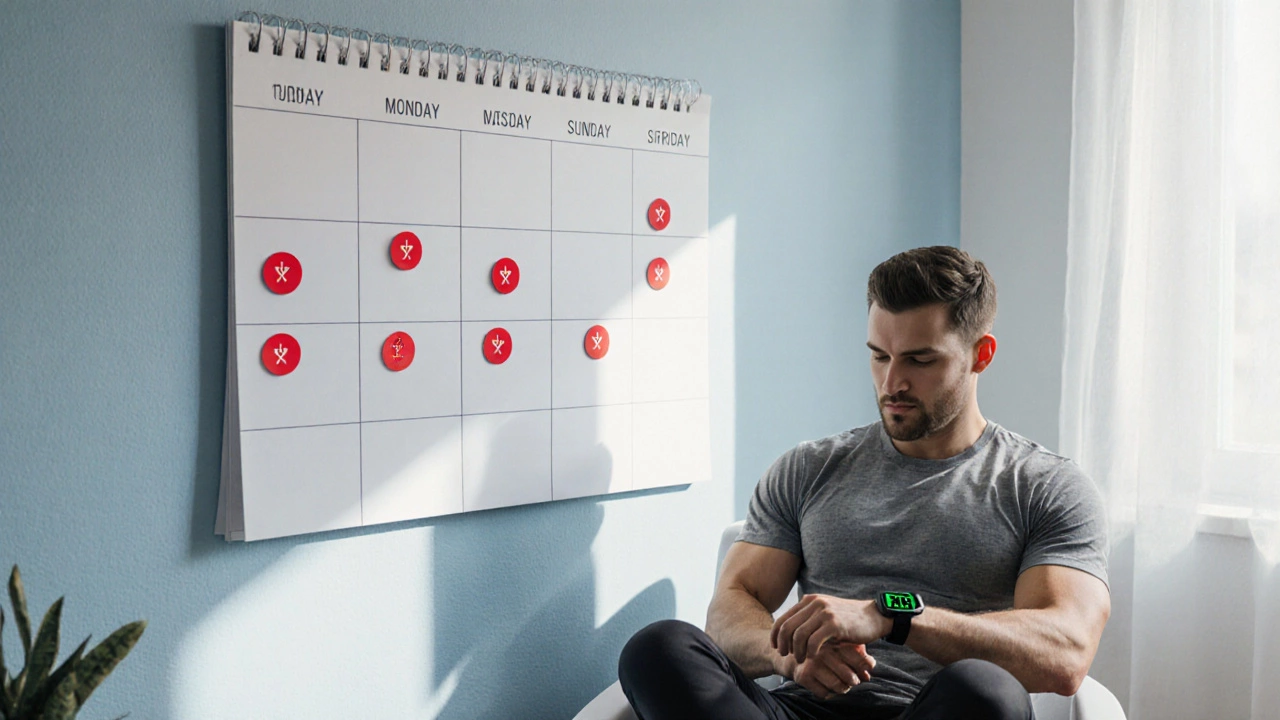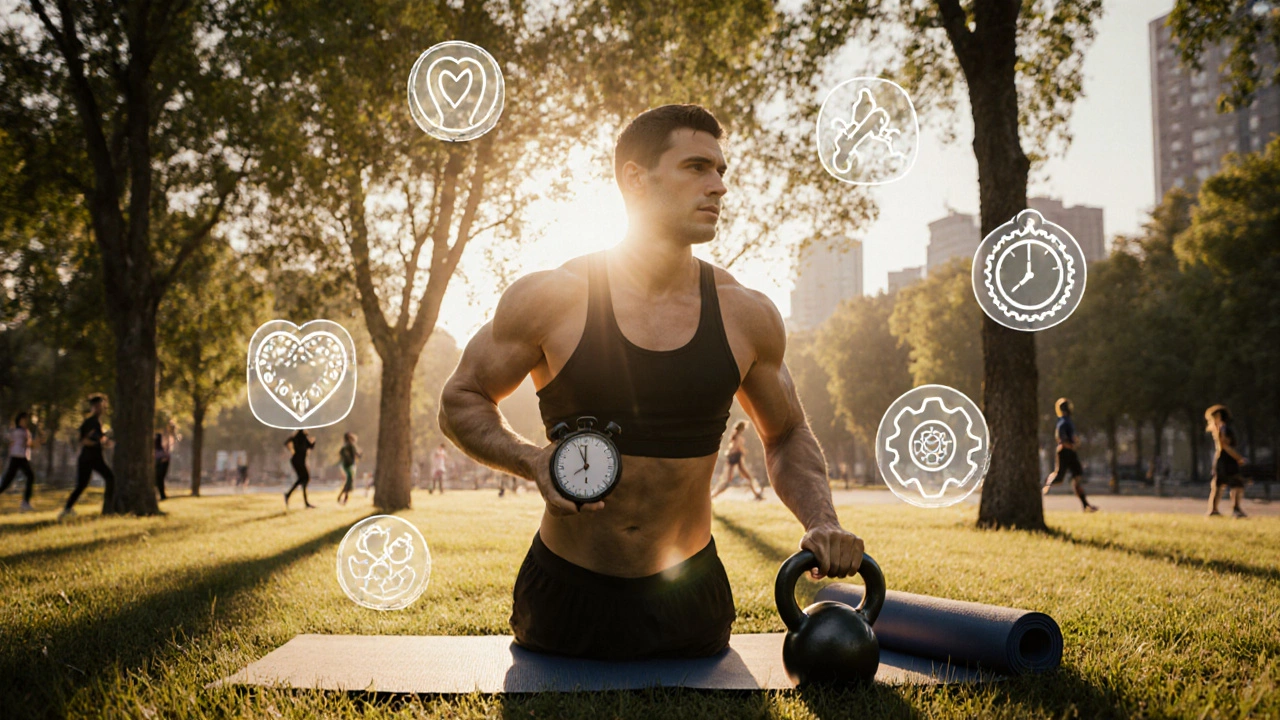Full-Body HIIT Calorie Burn Calculator
Calculate Your Calories Burned
Estimate calories burned during a full-body HIIT session based on your weight, duration, and intensity level
Estimated Calories Burned
Note: This is an estimate based on HIIT science. Actual calories burned vary based on individual factors and intensity.
Everyone asks, “What is the number 1 workout?” The answer isn’t a single piece of equipment or a trendy class-it’s a method that delivers the greatest bang for your buck in the shortest time. Below you’ll discover why a full‑body high‑intensity interval training (HIIT) session earns the top spot, see the exact moves you need, learn how to scale it for any fitness level, and compare it with other popular routines.
How We Rank a Workout as #1
Before naming the champion, we set clear criteria. A workout earns the top rank when it meets four pillars:
- Efficiency: Burns the most calories and builds strength in the least amount of time.
- Versatility: Works for beginners, athletes, and anyone in between.
- Scientific backing: Shows measurable improvements in VO₂ max, heart‑rate recovery, and muscle hypertrophy.
- Practicality: Requires minimal gear and can be done at home or in a park.
Only a routine that checks all four boxes can be crowned the #1 workout.
The #1 Workout: Full-Body HIIT
Full-body HIIT workout is a high‑intensity interval training session that targets every major muscle group in a short, calorie‑burning circuit. It mixes compound movements, rapid bursts, and brief rest periods to keep heart rate in the anaerobic zone, prompting both aerobic and strength gains.
Why does this format outrank traditional cardio or isolated weightlifting? The answer lies in metabolic conditioning-also known as MetCon. When you push hard for 20-30 seconds, you spike your lactate threshold, then tap into after‑burn calories (EPOC) during recovery. In a single 20‑minute session you can burn 300-500 calories, improve muscular endurance, and boost hormone levels that support fat loss.
Science Behind the Success
Researchers at the American College of Sports Medicine (ACSM) found that HIIT improves VO₂ max up to 15% in eight weeks-far better than moderate‑intensity steady‑state cardio. A 2023 meta‑analysis of 54 studies also showed HIIT elevates insulin sensitivity and growth hormone release, both key for building lean muscle.
In practice, the High-Intensity Interval Training (HIIT) structure creates a "double‑duty" effect: your cardiovascular system trains while your muscles lift, pull, and jump. That dual stimulus is why it dominates the ranking.

Sample 20‑Minute Full-Body HIIT Routine
Here’s a proven circuit you can do with just a kettlebell (or a dumbbell) and a mat. Perform each exercise for 40 seconds, rest 20 seconds, then move to the next. Complete three rounds.
- Burpee - a full‑body plyometric that spikes heart rate and engages the chest, shoulders, quads, and core
- Kettlebell swing - hip‑hinge power move that trains posterior chain and improves posterior chain explosiveness
- Push‑up - classic upper‑body strength exercise targeting pectorals, triceps, and anterior deltoids
- Jump squat - a compound lower‑body blast for glutes, hamstrings, and quads while maintaining cardio intensity
- Mountain climber - core‑centric cardio that also works shoulders and hip flexors
- Renegade row - combines plank stability with a pulling motion for back and biceps
Finish with a 2‑minute cool‑down of light jogging or walking, followed by static stretches for the major muscle groups.
Scaling the Workout for Every Level
Beginners: Reduce each work interval to 20 seconds and rest for 30 seconds. Replace kettlebell swings with body‑weight hip bridges, and stick to knee push‑ups.
Intermediate: Use the 40‑second/20‑second pattern shown above, but increase the kettlebell weight gradually (e.g., from 8 kg to 12 kg).
Advanced: Push the work interval to 45 seconds, rest 15 seconds, and add a weighted vest or increase kettlebell load to 16 kg. Introduce plyometric push‑ups or single‑leg squat jumps for extra challenge.

How It Stacks Up Against Other Popular Routines
| Aspect | Full‑Body HIIT | Traditional Strength Split | Steady‑State Cardio | Yoga Flow |
|---|---|---|---|---|
| Time per Session | 20‑30 min | 45‑60 min | 30‑60 min | 45‑75 min |
| Calorie Burn (avg.) | 300‑500 kcal | 200‑350 kcal | 250‑400 kcal | 150‑250 kcal |
| Strength Gains | Moderate‑High (compound focus) | High (isolated heavy loads) | Low | Low‑Moderate (body‑weight) |
| Cardiovascular Impact | High (anaerobic + aerobic) | Low‑Moderate | High (steady aerobic) | Moderate (mobility + light cardio) |
| Equipment Needed | Kettlebell or dumbbell | Barbell, rack, plates | Treadmill or bike (optional) | Mat only |
| Adaptability | Easy - modify intervals, weight, or moves | Moderate - need alternate exercises for injuries | Low - limited variation | High - pose‑based adjustments |
The table makes it clear why full‑body HIIT scores highest across the board when you need a balanced mix of strength, cardio, and time efficiency.
Common Mistakes and How to Avoid Them
- Skipping the rest: The 20‑second recovery isn’t optional. It resets your phosphocreatine system so you can keep intensity high.
- Poor form on compound moves: A bad squat or kettlebell swing turns a calorie‑burner into an injury risk. Start with light weight and perfect technique before adding load.
- Neglecting warm‑up: A 5‑minute dynamic warm‑up-leg swings, arm circles, and light jogging-prepares joints for the rapid transitions.
- Choosing the wrong weight: Too heavy reduces speed, too light lowers stimulus. Aim for a load that lets you finish the interval with 1‑2 reps left in the tank.
Tracking Progress and Measuring Results
To know you’re getting better, log three simple metrics after each session:
- Round time: Total time taken to complete all three rounds (including rests). Faster times indicate improved conditioning.
- Heart‑rate recovery: Measure beats per minute (BPM) one minute after finishing. A drop of 20+ BPM signals cardiovascular gains.
- RPE (Rate of Perceived Exertion): On a scale of 1‑10, note how hard the workout felt. Lower numbers over the same load mean you’re getting stronger.
Pair these with occasional body‑composition checks-skin‑fold measurements or a smart scale-to see fat loss and muscle gain.
Putting It All Together: Your Weekly Blueprint
For most people, three HIIT sessions per week, spaced with at least one rest or light‑activity day, yields optimal results. Example schedule:
- Monday - Full‑body HIIT (20 min)
- Tuesday - Light jog or brisk walk (30 min)
- Wednesday - Full‑body HIIT (20 min)
- Thursday - Mobility work or yoga (30 min)
- Friday - Full‑body HIIT (20 min)
- Saturday - Active recovery (hiking, swimming)
- Sunday - Rest
Stick to this pattern for eight weeks, then reassess the three metrics above. You’ll likely see a noticeable boost in stamina, strength, and body composition.
Frequently Asked Questions
Can I do full‑body HIIT if I have joint pain?
Yes, but modify the moves. Swap high‑impact jumps for low‑impact step‑backs, use a lighter kettlebell, and prioritize range‑of‑motion over speed. Always consult a physio if pain persists.
How often should I increase the weight in my HIIT routine?
When you can finish every interval with at least two reps left in the tank for three consecutive sessions, bump the weight up by 2‑4 kg. This keeps the stimulus progressive.
Is HIIT safe for beginners?
Absolutely, as long as you start with shorter work periods (15‑20 seconds) and longer rests (30‑40 seconds). Focus on form first; intensity comes later.
Do I need a gym membership for the #1 workout?
No. A single kettlebell (or a pair of dumbbells) and a small space are enough. All the moves are body‑weight friendly.
What’s the best time of day to do HIIT?
Morning workouts boost metabolism for the day, but the best time is when you’re most likely to stick with it. Consistency beats timing.
With the right structure, a bit of equipment, and a commitment to consistency, the number 1 workout can transform your fitness in just weeks. Give the full‑body HIIT routine a try, track your metrics, and watch your performance climb.





